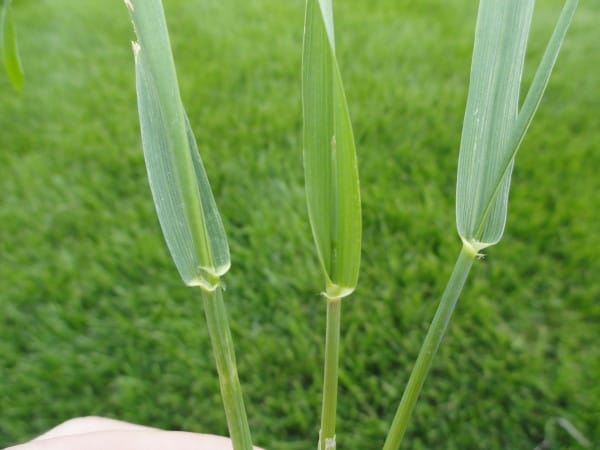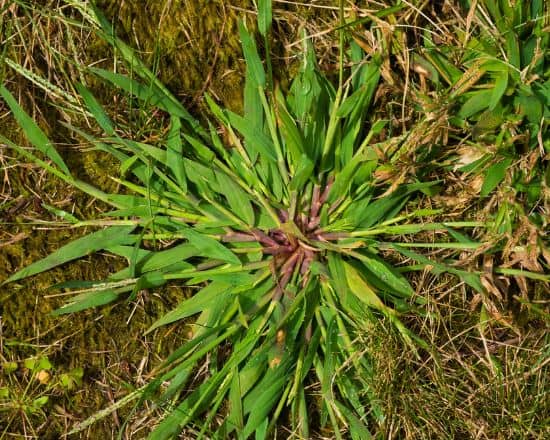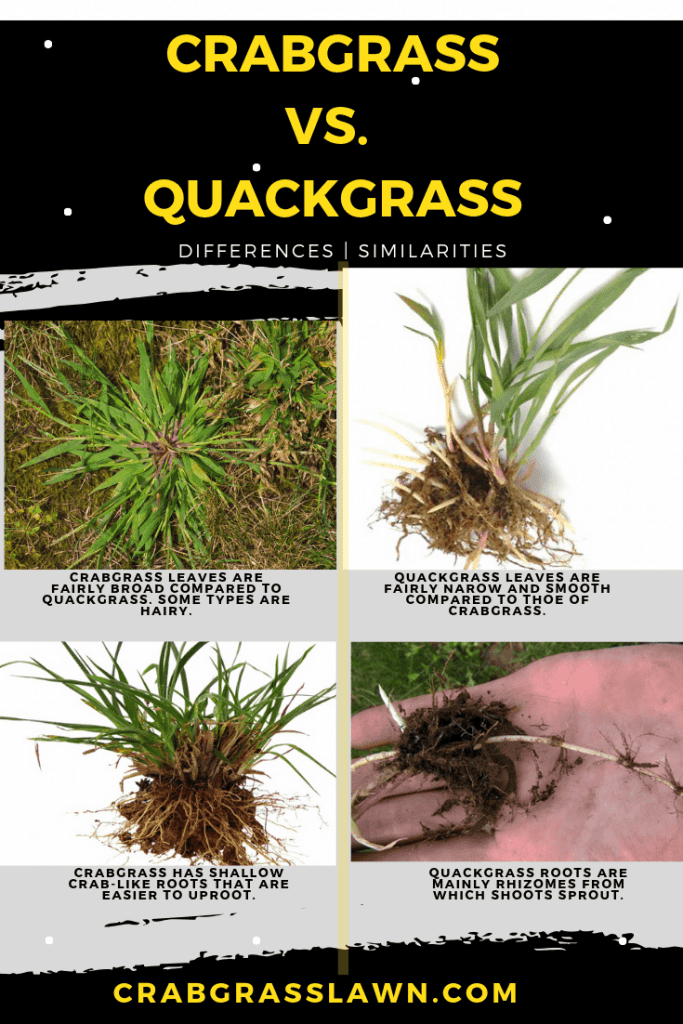Wondering which grass weed has invaded your lawn? Here’s a guide on the differences and similarities between crabgrass and quackgrass. We’ve included pictures to help you identify which of the two grass weeds you’re dealing with.
Crabgrass is a warm-season perennial grass while quackgrass is a cool-season perennial grass. Crabgrass roots form a shallow crab-like structure while a quackgrass root system forms rhizomes that grow horizontally and deep into the soil. Both of these weeds grow poorly in thick, shaded lawns.
To quickly kill quackgrass, this non-selective roundup herbicide does a great job, but to get rid of crabgrass, I would recommend Quinclorac crabgrass killers like this one.
Quackgrass Identification
Quackgrass is also identified as Elymus repens or Agropyron repens. Some people like referring to it as couchgrass. It is a perennial grass weed that’s easily confused with crabgrass and ryegrass. Most of these grasses have long tapered blades, but that of quackgrass differs a bit.
The common features of quackgrass that help with its identification include the following:

- The seedling leaves and stem sheaths are hairless.
- Mature plants are tall – reaching a height of up to 3 feet.
- Quackgrass leaves have auricles – finger-like projections that hook around the stem.
- Couchgrass has a deep root system that contains rhizomes.
The biggest challenge in getting rid of quackgrass is that when you till your land, you’ll likely cut the rhizomes below the surface. The remaining pieces start to form individual plants that grow and spread below and above the surface.
This characteristic growth pattern of quackgrass makes it so difficult to control. Roundup does a great job killing individual quackgrass weeds, but it becomes a challenge when your lawn is extensively invaded.
According to the U.S National Invasive Species Information Center, the impact of quackgrass is to crowd out native lawn grass and crops in the field it has invaded.
Crabgrass Identification
The scientific name of crabgrass is Digitaria sanguinalis. The name crabgrass comes from the development of its roots – growing low in the ground and stems sprouting right from the center of the clump. These resemble the image of a crab’s legs.
This weed is one of the worst lawn weeds thriving even during the hot season. When your lawn isn’t growing actively, crabgrass continues to grow and thrive, taking over your lawn within a short period.
Without the right crabgrass control measures, you’ll struggle to break the cycle of the weed and get rid of it completely.

- Crabgrass typically sprouts later in the season because it is a warm-season grass.
- Identifying crabgrass is quite difficult because it adapts easily to the environment. In some instances, there are hairy, smooth, short, long, Asian, and even Southern crabgrass varieties.
In the sections that follow, we’ll look deeper into the similarities and differences between crabgrass and quackgrass in terms of control, appearance, and growth patterns.
Quackgrass vs Crabgrass – The Differences
Here’s a table comparing crabgrass vs. quackgrass for the differences.
| Crabgrass | Quackgrass |
|---|---|
| Quackgrass grows from white underground rhizomes that continually grow. | Crabgrass roots form a crab-like structure that remain shallow in the ground. |
| Crabgrass is a warm-season grass that’s native to tropical and warm temperate regions. | Quackgrass, on the other hand, is a cool-season perennial grass. |
| The best way to get rid of crabgrass is to break it’s cycle from germination to maturity. | Quackgrass control is more difficult and requires preventive, mechanical, and chemical treatment. |
| Crabgrass shoots grow to form star-shaped stumps. | The stems and of quackgrass grow singly as they populate an area. |
| Crabgrass leaves grow independently from the stem. | Quackgrass leaves have auricles that hook around the stem. |
In terms of similarities, both quackgrass and crabgrass have thick coarse leaves. These usually stand out in lawns with common grasses such as Kentucky Bluegrass, Bermudagrass, and St. Augustine.
The main difference: Crabgrass has fairly shallow roots while quackgrass has deep-lying roots made up of rhizomes – underground stems that grow horizontally while the stems sprout from it.
Picture Comparison: Crabgrass or Quackgrass Infographic

Quackgrass Control Tips
Quackgrass is quite tough to get rid of being a cool-season perennial. It grows mostly in the cool season lawn grasses such as bluegrass, rye, and tall fescue.
The same root season can produce different leaves year after year. The root system strengthens a lot during winter. When the conditions change and become appropriate, it starts to grow and spread rapidly all over your lawn.
Characteristically, quackgrass thrives well in taller lawns. Why? Because if you allow it to have enough leaves, the root system develops better as opposed to when you mow your lawn a little bit lower.
Mowing at approximately 3 inches is a great cultural way to get rid of quackgrass naturally albeit slowly.
Here’s a quick start guide on how to get rid of quackgrass in your lawn:
Apply a non-selective herbicide
There’s a problem in trying to get rid of quackgrass compared to crabgrass. There are herbicides that specifically target crabgrass, but there are no chemical killers for quackgrass. That means that chemical control of quackgrass can only be done using a non-selective herbicide such as Roundup.
Mechanical control
Try hand-pulling if the infestation is not severe. Mowing, disking, plowing, and cultivating are also great ways to remove quackgrass but may not apply to already grown lawns.
Mulching
Both crabgrass and quackgrass weeds can be controlled by smothering methods. They do not do well in the shade, so apply a 2-3 inch layer of mulch to prevent them from sprouting.
Remember, quackgrass rhizomes can continue to spread beneath the surface and sprout when they find a spot to shoot from.
Crabgrass Control Guide
Choke out the shoots
To control crabgrass and get rid of it, try to fertilize your lawn adequately. Aim to get a healthy, thick lawn that forms a dense canopy that covers the soil. This prevents the germination of crabgrass seeds shortly after spring.
Mow the lawn 2 to 3 inches tall
If it’s time to cut and level the grass in your lawn, mow the grass a little higher to allow it to grow faster and choke the crabgrass out. Aim to mow at 2.5 to 3 inches tall to create enough shade and prevent the germination of crabgrass seeds.
Inhibit soil conditions
Crabgrass seeds start to germinate when soil temperature starts to rise to about 55°F. This is contributed to by sunlight, moisture, wind conditions, and the amount of shade in your lawn.
In order to prevent crabgrass germination in your lawn, care to achieve a luscious, thick lawn that will inhibit the proper soil conditions for the germination of this weed.
Apply crabgrass pre-emergent
Chemical control involves the use of pre-emergent and post-emergent herbicides. Quinclorac, Pendamethalin, and Drive 75 DF Herbicide are some of the best crabgrass killers on the market today.
Pre-emergents are great for control as well, but you have to be spot-on in their timing. Check out our guide on the best time to put down crabgrass preventer here.
Uproot the weed
If your lawn is already infested with clumps of crabgrass, the best way to get rid of it is uprooting. This is the best technique in the summer when the clumps have already spread and taken over the lawn. Simply reach down with your hand and grab the lowest part of the stem. Pull it out and dispose of it carefully to prevent spreading the seeds.
Apply weed killers (herbicide)
If you have a large lawn, going around and uprooting every single plant can be difficult. The best way to do it is by applying a post-emergent herbicide. Crabgrass killers such as Roundup and Ortho Weed B Gon are great for killing grassy weeds after germination.
Here’s a great video illustrating how to remove crabgrass in your lawn.
Click here for more lawn care and maintenance guides.
Hi, Alex Kuritz here. Growing up I remember that my family had one of the best lawns in the neighborhood. Richly green and lush. I did a lot as I grew up in terms of caring and tending for not only my family’s lawn but also my neighbors. I can say I have years of experience, and I am here to share it with you.



Crabgrass is a warm-season annual grass which grows best in the heat of midsummer when desirable lawn grasses are often semi-dormant and offer little or no competition. Crabgrass overwinters as seed, comes up about mid-summer.
Quackgrass and crabgrass look somewhat alike, but they are very different. For one thing, quackgrass is a cool-season perennial (note its ability to grow in the high mountains) where crabgrass is a warm-season annual. They have different ways of spreading and the short-term solutions for eradication are different. Long-term? solutions to crabgrass and quackgrass, however, are remarkably alike.
The table has reversed entries at the beginning.
Thanks Patricia, indeed they do. I’ll have my web guy edit the tables. 🙂
i have found that vinegar is a great product to kill anything that it touches and it works instantly you may not see any results for at least 24 hours but the reaction takes about three hours its cheap non toxic be careful anything that is sprayed with vinegar will die also this product was used at least one hundred years ago
Yep. Noticed the table problem right away, but got past it! Overall, info was very good! Helped confirm what I thought I knew! Thanks!